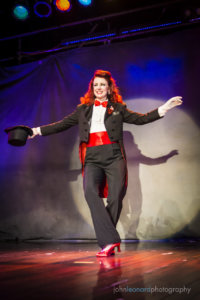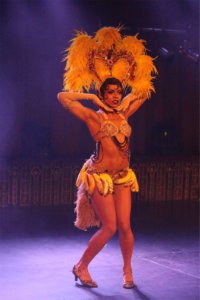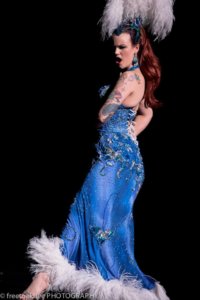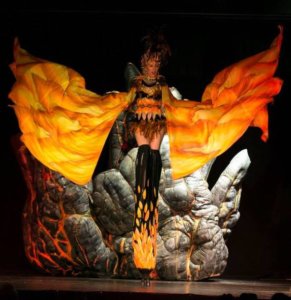All applicants who submit our application form for the Miss Burlesque competition must abide by all Rules & Criteria set out below:
Performers should be confident and of a high professional standard in the areas of performance, tease, audience engagement, visual presentation of costume and styling. They must demonstrate an innate understanding of music through demonstrating musicality within their movement and timing. Performer’s routines should be tight, well rehearsed and polished.
Order of competition sections & Scoring
 The competition will be comprised of three marked sections – the Red Carpet Parade, followed by the Traditional Routine and Unique routines. Each of these sections has their own scoring requirements as set out on this page.
The competition will be comprised of three marked sections – the Red Carpet Parade, followed by the Traditional Routine and Unique routines. Each of these sections has their own scoring requirements as set out on this page.
All guidelines for the competition are devised to create an entertaining and engaging show for the audience and simultaneously allow theatrical talent, intelligence and creativity to flourish. The rules and criteria are written to encourage artistic integrity while supporting a structure for judges to select a winner. The judges are looking for a well-rounded performer who can demonstrate different styles across the three sections.
Across these sections, we want to take the audience on a journey that displays your dynamic performance style.
RED CARPET PARADE
Contestant introduction Section
 The Red Carpet Parade is the opening section of the show. It’s your time to shine while the MC introduces you to the audience. This section judges on performance, confidence and the presentation of your character through movement, expression, gaze and gesture. Contestants are not required to wear an evening gown but we would love to see how glamour can be interpreted and presented. The outfit chosen should be over the top and have that intrinsic “wow” factor – whether that be vintage couture, a polished tuxedo or avant-garde wearable art.
The Red Carpet Parade is the opening section of the show. It’s your time to shine while the MC introduces you to the audience. This section judges on performance, confidence and the presentation of your character through movement, expression, gaze and gesture. Contestants are not required to wear an evening gown but we would love to see how glamour can be interpreted and presented. The outfit chosen should be over the top and have that intrinsic “wow” factor – whether that be vintage couture, a polished tuxedo or avant-garde wearable art.
Rules
- The contestant must wear an outfit that is separate to their performance costumes.
- No props or back-up dancers are permitted during the parade section. Accessories such as feather boas, stoles, parasols are acceptable.
TRADITIONAL
Traditional Burlesque Performance (1880s-1960s)
 The traditional section is about capturing the heart and essence of the period when burlesque was at it’s the zenith. This section seeks to represent this unique period within history.
The traditional section is about capturing the heart and essence of the period when burlesque was at it’s the zenith. This section seeks to represent this unique period within history.
The traditional section encourages performers to engage with researching and understanding the origins of burlesque. The rise of neo-burlesque comes from a place of nostalgia and this section is where we can uphold the historical roots of striptease, pay tribute to our stripping foremothers and honour the rich and deep history of burlesque.
Note: We have consciously moved away from naming this category as “classic” because we argue that “classic” burlesque within the neo-burlesque era is not defined or limited by music, costume or aesthetic, but more as a style evoking tease, with tease being the paramount objective. Classic is therefore not separate from modern, neo-burlesque music, stylings or vintage aesthetic. There are many excellent examples of expert classic burlesque performers who transcend the genre of which this category originally inhibited.
We encourage performers to look at a range of theatrical spaces that burlesque was performed in, such asboth tent and small-scale performance spaces and high-class theatrical stylings. We encourage performers to undertake their own research and incorporate a wide range of inspiration, whether pictorial or film.
Here are some of the following styles of traditional striptease:
- Bump and Grind

- Hootchy-kootch
- Shake dancing
- Strut and strip (gown to garments)
- Elegant high theatre/variety of grand-scale stage productions
- Pantomime and pre-turn of the century parody
- Prop stylings such as serpentine, fan dance, half/half
A note on dates of this genre:
The century chosen 1880s-1960s is a guide for the traditional section. There is no specific year or date, however, these decades are chosen specifically for their historical importance. The roots of burlesque grew out of the late 1800s British actress Lydia Thompson and her troupe the British Blondes. Miss Burlesque acknowledges that burlesque existed prior to Thompson but as a theatre style based on parodies of plays that mixed classical theatre with humorous commentary on events of the day.
The “Golden Age of Burlesque” was a time when every major city throughout the United States had multiple burlesque houses. Miss Burlesque uses the 1960s as a point of demarcation of the Golden era of burlesque in line with scholarly histories dating the “death” of American burlesque to the mid-century demise of the burlesque theatre. However, we would like to acknowledge that burlesque did not die, but rather evolved throughout these pivotal decades into modern exotic dance. We would also like to honour the many great legends of traditional burlesque who continued to perform well into the 1970s and beyond.
The music chosen is to be reflective of eras that relied upon live music (such as in-house bands, live improvisational jazz and vaudeville theatre pit orchestras). Choose music appropriate to the style of theatre and era you are emulating. If in doubt check with your state producer.
Rules
- Routine must run for a minimum of 3 mins and a maximum of 5 mins.
- The traditional burlesque performance must evoke a sense of the past glory of burlesque from a time that it was at its peak of popularity.
- Routine, costume, music and all styling’s must reflect a historical understanding of the origins of We roughly argue that these dates fit within the century 1860-1960 (however, performances can be inspired by burlesque legends and icons from the 1960s and 70s).
- Contestants must use music that reflects the era in which their traditional act has been inspired from. eg: modern Big Band Swing tracks are allowed, however, not remixed versions. If in doubt check with your producer.
- Judges will be looking at the quality of costuming and overall visual aesthetic.
- Small props are permitted as long as approved by producer in lead up to show. Set-up is permitted.
- An element of Tease is required in the act.
- Stagehand assistance and audience interaction is permitted.
- NO MESS – Due to time constraints and venue regulations there is to be no mess that requires clean up in the routine. This refers to the use of glitter, confetti, mylar, streamers and liquids.
- While we acknowledge the great tradition of chorus girls and troupes – due to the confines of the competition and limits on timing and backstage access we are limiting this section to solo performance. Back-up dancers/dance partners/walk-ons are not permitted during this section.
Performer will be judged on Engagement – Use of Stage, Audience Connection, Styling – Costuming, Visual Presentation, Movement, Music & Musicality as well as Tease & Performance.
UNIQUE
 In the immortal words of Gypsy Rose Lee, “You gotta get a gimmick!” Well, gimmick or no gimmick this is the performers chance to show the audience their modern interpretation of burlesque. We want performers to consider how striptease can be innovative to burlesque as an art form. We want to see a well-developed character and demonstrate an understanding about their own unique persona.
In the immortal words of Gypsy Rose Lee, “You gotta get a gimmick!” Well, gimmick or no gimmick this is the performers chance to show the audience their modern interpretation of burlesque. We want performers to consider how striptease can be innovative to burlesque as an art form. We want to see a well-developed character and demonstrate an understanding about their own unique persona.
Overall, we want this to be entertaining. This section can be conceptual, classic, narrative or performance art – we want the performers to only be limited by their own imagination. Overall, we want to see what the performer can do. We want to see their biggest and best routine. Performers should make us think, make us scream; make us feel something through their performance. We want the performers to be adding to the knowledge pool of burlesque, not recreating things that have been done before.
In this section performers can perform any style or genre of burlesque – be that conceptual, performance art, narrative story telling, classic, circus, vaudeville – as long as it involves an element of striptease.
Rules
- Routine must run for a minimum of 4 mins and a maximum of 5 mins.
- There are no rules in regard to costuming, music and styling.
- Major props are permitted but must not take any more than 2 mins to set up or remove. Major props are to be discussed with the producer and they will make the executive decision dependent on venue or extenuating circumstances.
- Weighted stages and aerial rigging are permitted for this show if the venue allows. It’s up to the contestant to cover the cost of setting up, rigging and must be prepared prior to the event to allow for quick set up for the stage. Riggers must be industry certified.
- Backup dancers are permitted for this section.
- Stagehand assistance and audience interaction is permitted.
Performer will be judged on Individuality, Character & Performance, Engagement – Use of Stage, Audience Connection, Styling – Costuming, Visual Presentation as well as Tease, Movement & Musicality.
GENERAL SHOW RULES:
- Xpole’s are not permitted in this competition at all.
- Please ensure costume and styling are separate looks for each show.
- NO MESS – Due to time constraints and venue regulations there is to be no mess that requires clean up in the routines. This refers to the use of glitter, confetti, mylar, streamers and liquids.
- Animals are not allowed in any Miss Burlesque UK showcase.
Statement on appropriate behaviour
Miss Burlesque is committed to providing a platform to build a positive and supportive environment for the UK burlesque community. We aim to support a thriving and diverse space in which performers both new and old can develop the artform and foster relationships with one another. All Finalists are expected to conduct themselves in a professional manner at all times.
Miss Burlesque aims to uphold an inclusive and positive theatrical space that encourages body, race, ethnicity and political diversity.
Bullying
Bullying is defined as, “an ongoing and deliberate misuse of power in relationships through repeated verbal, physical and/or social behaviour that intends to cause physical, social and/or psychological harm.”
Bullying can occur in both physical and online spaces. This behaviour does not promote a positive, inclusive or supportive community environment and is deemed unacceptable behaviour within the MBUK competition. Any competitor aiming to negatively influence or intimidate another competitor or member of the MBUK production team will be found to be in violation of the terms and conditions of the entry of the competition and will be asked to leave the MBUK and will be barred from entering in concurrent years.
Cultural Appropriation
Cultural Appropriation is defined as, “the act of taking or using things from a culture that is not your own, especially without showing understanding or respect to this culture.” Cultural appropriation occurs when “members of a dominant culture take elements from a culture of people who have been systematically oppressed by that dominant group.”
Cultural appropriation has occurred with great frequency throughout the history of burlesque, and we believe that the continuation of this causes harm and perpetuates hurt.
Miss Burlesque has a strict policy against accepting acts and performers that depict cultural appropriation on the stage. If a performer is found to be creating an act that seeks to depict acts that marginalise any culture that is not their own, they will be barred from entering the competition in concurrent years.